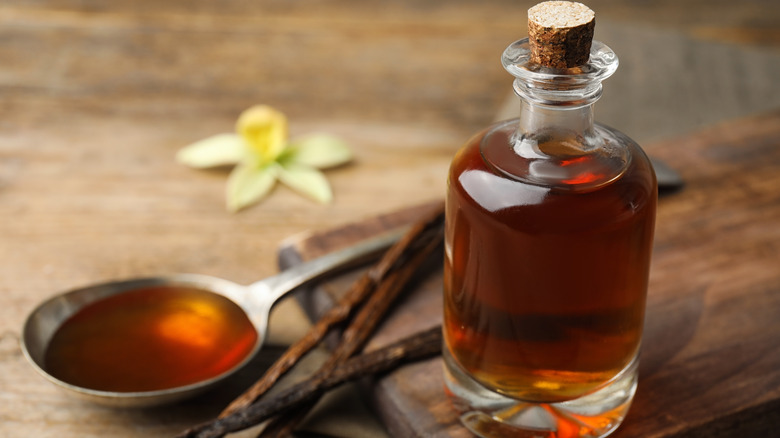Vanilla Wouldn't Have Been As Popular Without Thomas Jefferson
In the U.S. of 2023, vanilla is ubiquitous. Bakers are constantly encouraging you to add vanilla to your cookies and cakes, and, according to a 2022 YouGov poll, it's the most-liked ice cream flavor in the United States. Over half of Americans like the flavor, and nearly a tenth of Americans call it their favorite flavor of all, both figures rank the highest among all ice cream flavors.
But vanilla has not always been an American staple. At the time of the United States' founding, the plant was unlikely to be used in American kitchens. More than a decade after the signing of the Declaration of Independence, Thomas Jefferson returned from France in 1789 after his ambassadorship, and brought back some of his favorite foods from France, including vanilla, french fries, and macaroni pasta. And while Jefferson did not introduce ice cream to America, he did popularize it, and his recipe for ice cream — unsurprisingly — called for a stick of vanilla.
The origins of vanilla
Vanilla is a member of the Orchidaceae, or orchid, family of plants. Originally grown in Mexico, the plant was brought to Europe by colonizers, but they were disappointed to find that it was impossible to grow the plant in Europe. This is because the plant's natural pollinator is native to Mexico, not Europe.
In 1841, an enslaved boy named Edmond Albius came up with a labor-intensive method for hand pollination, opening up the possibility for farmers to cultivate vanilla without its natural pollinator. Nowadays, this is how most of the world's vanilla is pollinated, making it the only hand-pollinated plant in the world. With hand pollination, vanilla is grown globally, although most of the world's vanilla comes from Madagascar.
Even with hand pollination, the supply of natural vanilla is still very low. Shockingly, less than 1% of the vanilla flavoring in the world is actually drawn from vanilla beans. The truth about vanilla is that when, in the 19th century, demand for vanilla began to exceed supply, people began to make synthetic vanilla flavors. Those flavors make up the vast majority of the vanilla flavoring on the global market.
Is vanilla plain?
Somehow, in more recent times, vanilla has become a moniker for something boring or bland. It is a curious development, considering that the plant is in such high demand that vanilla farmers in Madagascar have to arm themselves to protect their crops from bandits. Indeed, the small crops are the world's second most expensive spice, only after saffron, a fact that hardly suggests it is "lacking distinction" as Merriam-Webster suggests of the term 'vanilla'.
One way to combat this negative attitude towards vanilla is to invest yourself in the process and make homemade vanilla extract. While vanilla is expensive, you can extend its life by turning a couple of vanilla bean pods into extract. Handmade vanilla extract is anything but lacking distinction, and the labor you put in will match your love for the beloved flavor and ingredient. Then you can try out Thomas Jefferson's famous recipe for ice cream — or another vanilla ice cream recipe — and see why vanilla became so popular.


